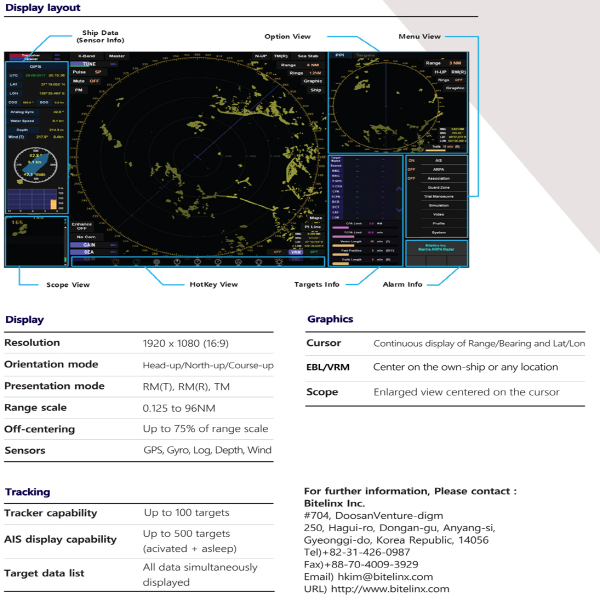ASDE

ASDE (Airport Surface Detection Radar)
- 1. IF Bandwidth: Short pulse – 28MHz | Long pulse – 20MHz
- 2. IF signal size: max. ±10dBm
- 3. STC control range: 70dB
- 4. Pulse width: Short pulse – 75ns | Long pulse – 7.5us
- 5. Standard PRF: 8192MHz
Equipment component

Radar Viewer
The BRS - RV
is a radar image plotter that encompasses the embedded hardware and the GUI viewer. The radar viewer has been so designed to comply with the specifications in IEC. 62388. The straightforward graphical user interface allows users to access most functions with a single click and the layout of the menus is best suited to marine radars. On top of the general radar utility functions, the BRS-RV provides users with ARPA, one of the most important functions for safe navigation. The reliability of the software has been tested and verified by a certified institute.

- Integrated display & control over a full-featured radar
- Best fit for a marine radar system
- IMO reg ulations and standards compliant
- 1920 X 1080 resolution, 16:9
- Dual PPI for safer navigation
- 100 targets trackable by ARPA
- Display of Up to 500 vessels identified by AIS
- Supplementary functions
- Both conventional analog & digital interfaces
Radar utilities
While displaying radar image, the BRS-RV provides users with easy access to all functions with a full-featured BRS-MM radar signal processor, including STC control, clutter filtering, target enhancement and PRF staggering as described in the standard, IEC 62388. The implementation of the software complies with IEC 62288, 61162 and 60945 as well as the relevant IMO regulations. The dual PPI and guard zone functions are also provided for safer navigation.
ARPA
ARPA is another costly, but effective option for safe navigatlon The BRS-RV invokes a state-of-art adaptive filtering technique in implementing ARPA. It tracks as many as 100 targets either automatically or manually. The tracking information shown on the display is updated every second. Once any target approaches within the preset boundary, an alarm will be issued to warn the operator of the possibility of collision. The ARPA in cooperation with AIS enhances navigational safety. The tote table in the display manages and shows up to 6 targets identified by ARPA and AIS
Other features
Tlhere are some supplementary functions that add value to the BRS-RV. The scan-to-scan filtering reduces the probability of false detection. A variety of diagnostic and monitoring functions enable the user to not only take a proper action against a defect in advance but also maintain the radar system more transparently. The BRS-RV supports interfaces with such adjacent systems as AIS for safe navigation
Equipment component

ARDM

To process the signal and transmit the result to the display by producing radar pulse, and transfer to the RF transmitter, then receive the signal from RS receiver which is reflected from the object.

Equipment component

HCA

Produce and operate the pulse by FPGA based High speed parallel signal processing upon distance.
Optimizing the dynamic input range via applying STC by using enhancing the signal from receiving path and using noise rejection algorithm.
Optimizing the dynamic input range via applying STC by using enhancing the signal from receiving path and using noise rejection algorithm.

Equipment component

Radar Signal Processing Module
The BRS-MM/SM
Series are high-speed radar signal processing modules. The modules inc lude a transmitter for pulse generation and a receiver to process the reflected target signals. The BRS-MM is a signal processing module for a magnetron-based marine radar. The BRS-SM has signal processing module for SSPA-based radars, used in ground or aircraft applications. The integrated high DSP techniques have been proven to be reliable and superior in the field.

- Signal processors for X-band magnetron & SSPA
- Up to 30MHz IF bandwidth, 100/125MHz IF
- Chirped NLFM pulse (BR5-5M)
- Auto frequency calibration (BR5-MM)
- IEC62388 compliant (BR5-MM)
- Frame-based pulse operation (BR5-MM)
- Frequency diversity & agility (BR5-MM)
- CFAR, STC, PRF stagger, pulse integration
Electrical features
Users can choose the intermediate frequency, either 100MHz, 125MHz or another specific frequency at the time of ordering. The signal bandwidth can be configured to be 30MHz max. It depends on the distance of the target. The input dynamic range is as wide as 50dB, 0 to -50dBm, regardless of the STC. The detection results are available for both analog and digital interfaces, and users can choose either one. The conventional analog interface consists of a set of signals, analog video, trigger, ACP and ARP. The digital interface is based on the Ethernet and accompanied by a compact protocol.
Signal processing
AII key functional blocks are implemented on a single integrated processor, minimizing the analog circuit. The BRS-SM invokes the NLFM pulse compression technique intended for application to SSPA-based radars. They also operate a frame-based pulse where multiple pulses of different lengths are slmultaneously transmitted and received while the BR5-MM transmits a single pulse. The BRS-MM for magnetron-based marine radars has been fully tested under the conditions specified in IEC 62388. High DSP techniques applied include frequency diversity, CFAR, STC, PRF stagger, pulse integration, DDC and so on. The performance of those integrated in an ASDE has been tested in the field.
Supplementary functions
Besides the main features, the BRS-SM/SM series each have such useful fundions as AFC, Static/Blanking MAP, pulse expansion, ARP/ACP trigger manipulation, BIT and so on.
Configurable registers
The configurable registers allow users to have easy access to the highly flexible combination of features.
Equipment component

